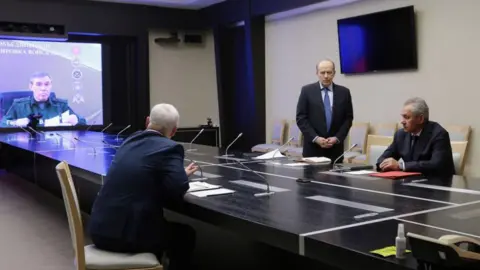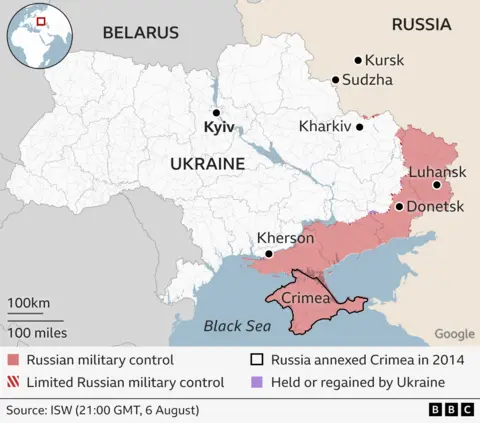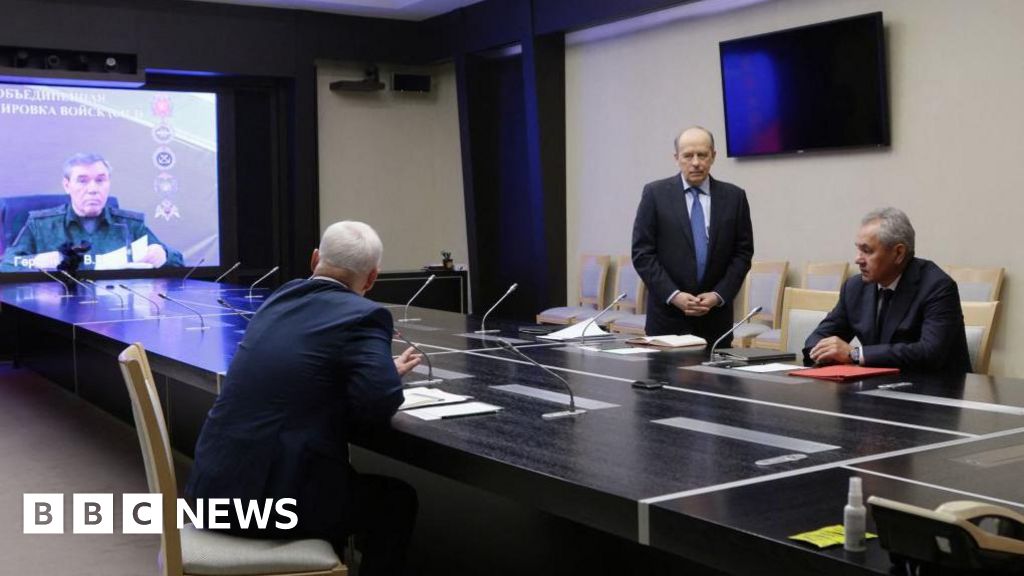 AFP via Getty Images
AFP via Getty ImagesHeavy fighting in Russia’s Kursk region has entered a third day, with efforts “ongoing” to expel Ukrainian forces from the country, Moscow’s defence ministry has said.
Russia says at least 1,000 Ukrainian forces, supported by tanks and armoured vehicles, crossed the border on Tuesday.
Some 3,000 people have had to evacuate the region, as ongoing military altercations have killed at least four people, Kursk’s deputy Governor Andrei Belostotsky said on Thursday.
Ukraine’s military has maintained a resolute silence on the allegations, but a senior adviser to President Volodymyr Zelensky has blamed “Russia’s unequivocal aggression” for any “military actions”.
Mykhailo Podolyak, a long-term aide to President Zelensky added: “War is war, with its own rules, where the aggressor inevitably reaps corresponding outcomes.”
Russia’s defence ministry said advancements and “breakthrough attempts” by the Ukrainian army’s formations in the Sudzhansky and Korenevsky districts in Kursk were thwarted in a combined effort from the Federal Security Service (FSB) and the military.
The Kremlin said Ukraine had lost 660 military personnel since the start of hostilities in Kursk. Mr Belostotsky claimed Kyiv’s forces were beginning to retreat from the region.
The BBC is unable to verify death tolls in active conflicts, and fatalities reported by adversaries are often not a true representation of the situation on the ground.
In its update on Thursday Moscow said Kyiv had lost 82 units of armoured vehicles. A much higher number than its initial report that 11 tanks and more than 20 armoured vehicles had entered Russia near the town of Sudzha on Tuesday morning.
Also on Thursday Russia suggested, for the third consecutive day, to have stopped Ukrainian troops from advancing in Kursk.
But on Wednesday, Russia’s Chief of General Staff Valery Gerasimov said the “advance” into the Kursk region had been stopped, with Russian forces “continuing to destroy the adversary in areas directly adjacent to the Russian-Ukrainian border”.
While the FSB made claims to a similar effect on Tuesday, when initial reports of a potential Ukrainian incursion surfaced.
In its latest report, the Institute for the Study of War, a well-respected think tank, said geolocated footage from the past two days showed that Ukrainian armoured vehicles have advanced to positions 10km (6.2 miles) into the Kursk region.
Meanwhile, footage verified by the BBC has shown fighter jets flying low overhead in the region in recent days.

Russia’s military leadership is under severe scrutiny domestically, as some popular and generally well-informed pro-war Telegram channels have said the situation on the ground is not as stable as the Kremlin has suggested.
The influential pro-war Rybar Telegram channel went on to strongly criticise the highest ranks of the Russian military on Wednesday, saying that “for two months the full information was sent to the useless headquarters”, adding that there was enough time “to make an appropriate decision”.
Rybar’s concerns were echoed by several other pro-war bloggers.
Local leaders in regions adjacent to Kursk, both in Russia and in Ukraine, ordered residents to evacuate the area since news of the incursion.
On Wednesday, the head of the Ukrainian region of Sumy, Volodymyr Artyukh, ordered the evacuation of areas bordering Kursk.
While in the Russian region of Belgorod, governor Vyacheslav Gladkov said on Thursday that settlements across his province were attacked by Ukrainian forces over the past 24 hours.
This is not the first incursion into Russia by fighters based in Ukraine. Some groups of anti-Kremlin Russians launched raids last year, which were repelled.
The forces crossed into the Belgorod and Kursk regions again in March, where they engaged in clashes with Russian security forces.
On Wednesday evening, Ukrainian MP Oleksiy Honcharenko said the Ukrainian army had established control over the Sudzha gas hub, a major gas facility involved in the transit of natural gas from Russia to the EU via Ukraine, which has continued despite the war.
It is the only point of entry for Russian gas into the EU.
But on Thursday gas was reportedly still flowing from Sudzha.
Russia’s National Guard said it had reinforced security around Kursk’s nuclear power station, which lies some 70km north-east of Sudzha.
For the past few months Russia has made incremental gains in eastern Ukraine, as many of Kyiv’s ground forces have faced relentless attacks in the eastern Donbas region.
In a recent interview Ukraine’s head of defence intelligence, Kyrylo Budanov, said the main offensive by Russian forces “is expected to be over in a month and a half to two months”.


